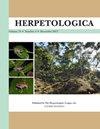易位对地鼠蛙生存和运动的影响
IF 1.1
3区 生物学
Q2 ZOOLOGY
引用次数: 0
摘要
摘要:易位越来越多地用于将受保护的动物从栖息地将被破坏的地点转移(缓解易位),但结果很少得到充分的监测,特别是对两栖类动物。在美国佛罗里达州中北部的一个接收点,我们使用无线电遥测监测来评估23只实验性迁移的成年地鼠蛙(Lithobates capito)的生存和运动情况。虽然易位后监测是我们的主要目标,但我们也将我们的结果与之前三次在不同地点和时间监测的24只非易位青蛙的结果进行了比较。对于易位和非易位的青蛙来说,运动是最重要的死亡率预测指标,易位的青蛙在释放后的第一个月有明显更高的运动概率和更高的死亡率。然而,在控制移动概率后,由于移动对易位和非易位的青蛙都是危险的,因此易位对存活没有影响。易位青蛙的移动可能是对易位经历的一种行为反应,而非易位青蛙的移动与繁殖池塘的访问有关,这在易位组中没有观察到。一旦他们进入地下避难所,活动减少,这两个群体的存活率都很高。尽管迁移的青蛙在释放后立即死亡率相对较高,但超过一半的青蛙存活到监测结束并留在释放地点附近,达到了迁移成功的早期基准。本文章由计算机程序翻译,如有差异,请以英文原文为准。
Effects of Translocation on Gopher Frog Survival and Movement
Abstract: Translocation is increasingly used to move animals of conservation concern away from sites where habitat will be destroyed (mitigation translocation), but outcomes have rarely been adequately monitored, particularly for amphibians. We used radiotelemetry monitoring to assess survival and movement of 23 experimentally translocated, adult Gopher Frogs (Lithobates capito) at a recipient site in north-central Florida, USA. Although posttranslocation monitoring was our primary goal, we also compared our results with those of 24 nontranslocated frogs that were monitored in three previous efforts, conducted at different locations and times. For both translocated and nontranslocated frogs, movement was the most important predictor of mortality, with translocated frogs having a significantly higher probability of movement and higher mortality during the first month following release. However, there was no effect of translocation on survival after controlling for probability of movement because movement was dangerous for both translocated and nontranslocated frogs. Movement by translocated frogs was likely a behavioral response to the translocation experience, whereas movement by nontranslocated frogs was associated with breeding pond visitation, which was not observed within the translocated group. Survival was high for both groups once they settled into underground refugia and movement declined. Despite the comparatively high mortality of translocated frogs immediately following release, more than half survived to the end of monitoring and remained in the vicinity of the release site, meeting an early benchmark of translocation success.
求助全文
通过发布文献求助,成功后即可免费获取论文全文。
去求助
来源期刊

Herpetologica
生物-动物学
CiteScore
4.60
自引率
0.00%
发文量
27
审稿时长
>12 weeks
期刊介绍:
Established in 1936, Herpetologica is a quarterly peer-reviewed journal serving herpetologists, biologists, ecologists, conservationists, researchers and the scientific community. The journal contains original research papers and essays about the biology of reptiles and amphibians, and covers many relevant topics including: behavior, conservation, ecology, genetics, morphology, physiology and taxonomy.
 求助内容:
求助内容: 应助结果提醒方式:
应助结果提醒方式:


